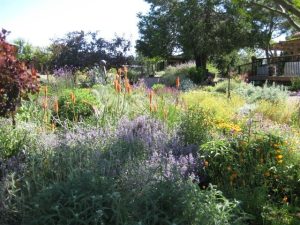Habitat Gardening Basics
Habitat gardening is easy, no special skills required. However, there are basics one should keep in mind when considering a habitat garden.
Water is an essential need for birds in the garden. There is nothing more delightful than to watch the hummingbirds and finches bathing and drinking in my recirculating waterfall and pond. Moving water is especially attractive to birds. Not only does my wildlife pond and stream attract birds, but it also draws in frogs, dragonflies, foxes and nocturnal animals. Water in the habitat garden can be provided in numerous ways, from very simple to elaborate (such as the recirculating stream and pond above). A simple saucer can be carefully placed where birds can quickly escape to a bush or tree for safety, or high enough and inaccessible to feral and domestic cats. Placing a few stones in a shallow saucer of water is also a great way to provide water for butterflies and other insects. It is important to keep birdbaths, saucers and other watering holes clean and filled with fresh water daily to prevent mosquito breeding.
When planting your habitat garden keep in mind that you want to imitate nature. Provide different layers of ground covers, shrubs and trees to provide shelter, nesting and foraging sites for birds. Manzanita (‘Howard McMinn’), Ceanothus (California Lilac) and Oregon grape are perfect examples of native plants that birds use for shelter and foraging sites. Brush piles and woodpiles are essential for quail to nest and retreat to. Remember to diversify. Try to provide a wide variety of regionally appropriate food and nectar plants that flower at different times of the year. Remember that native plants have evolved with the different wildlife in the area, so it is important to emphasize native plantings. Don’t be so eager to prune and clean up. Again, you’re trying to imitate nature. Let trees and shrubs reach their normal size, flower, and set fruit. Allow flowers, such as Rudbeckia (Black-eyed Susan) and yarrow, to go to seed for a food source during the winter.
Wildlife gardens are easy to maintain, conserve water and require no fertilizers, pesticides or herbicides. Try to recycle plant material as compost, leaf mulch, or small brush piles. Remember, nothing comes into the garden that is toxic; nothing leaves the garden that is organic.*
Upcoming articles will discuss the specifics of habitat gardening with regards to the plants that work best in habitat gardens, and the needs of specific birds, amphibians, reptiles, and beneficial insects in the garden.
.*Bauer, Nancy The California Wildlife Habitat Garden, University of California Press 2012
Wendy Weidenman is a University of California Cooperative Extension Master Gardener of Tuolumne County. UCCE Master Gardeners of Tuolumne County can answer home gardening questions. Call 209-533-5912 or go to: http://ucanr.edu/survey/survey.cfm?surveynumber=7269 to fill out our easy-to-use problem questionnaire. Check out our website at: http://cecentralsierra.ucanr.edu/Master_Gardeners/ You can also find us on Facebook or pick up the local UCCE Master Gardener book “Sharing the Knowledge: Gardening in the Mother Lode” at Mountain Books or the UCCE Office both in Sonora, CA

